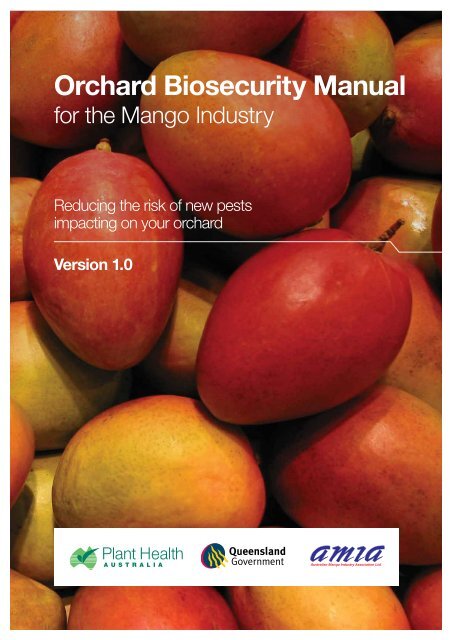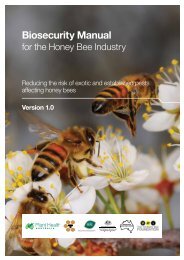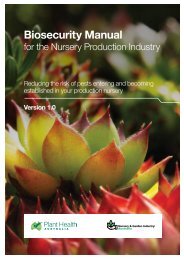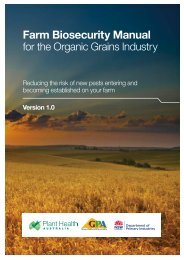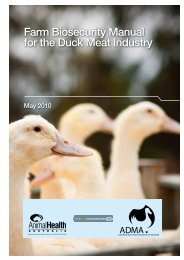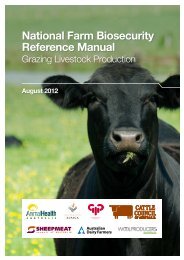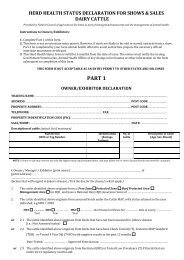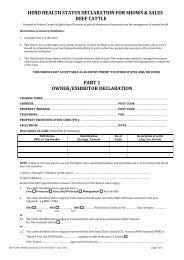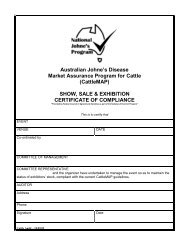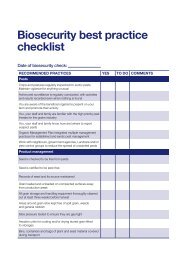Orchard Biosecurity Manual for the Mango Industry - Farm Biosecurity
Orchard Biosecurity Manual for the Mango Industry - Farm Biosecurity
Orchard Biosecurity Manual for the Mango Industry - Farm Biosecurity
Create successful ePaper yourself
Turn your PDF publications into a flip-book with our unique Google optimized e-Paper software.
<strong>Orchard</strong> <strong>Biosecurity</strong> <strong>Manual</strong><br />
<strong>for</strong> <strong>the</strong> <strong>Mango</strong> <strong>Industry</strong><br />
Reducing <strong>the</strong> risk of new pests<br />
impacting on your orchard<br />
Version 1.0
Plant Health Australia (PHA) is <strong>the</strong><br />
national coordinator of <strong>the</strong> governmentindustry<br />
partnership <strong>for</strong> plant biosecurity<br />
in Australia. As a not-<strong>for</strong>-profit company,<br />
PHA services <strong>the</strong> needs of Members and<br />
independently advocates on behalf of<br />
<strong>the</strong> national plant biosecurity system.<br />
PHA’s ef<strong>for</strong>ts help minimise plant pest<br />
impacts, enhance Australia’s plant<br />
health status, assist trade, safeguard<br />
<strong>the</strong> livelihood of producers, support <strong>the</strong><br />
sustainability and profitability of plant<br />
industries and <strong>the</strong> communities that rely<br />
upon <strong>the</strong>m, and preserve environmental<br />
health and amenity.<br />
www.plan<strong>the</strong>althaustralia.com.au<br />
<strong>Biosecurity</strong> Queensland and<br />
Agri-Science Queensland, services of <strong>the</strong><br />
Department of Employment, Economic<br />
Development and Innovation (DEEDI),<br />
are working to promote profitable<br />
primary industries <strong>for</strong> Queensland.<br />
This is achieved by providing expertise<br />
and support to assist <strong>the</strong> state’s<br />
food and fibre industries to increase<br />
productivity, improve sustainability,<br />
grow markets and adapt to change.<br />
DEEDI is committed to delivering<br />
world-class research and development,<br />
providing leadership on industry policy,<br />
protecting industries against pests and<br />
diseases, maintaining animal welfare<br />
standards and managing fisheries<br />
sustainably.<br />
www.deedi.qld.gov.au<br />
The Australian <strong>Mango</strong> <strong>Industry</strong><br />
Association (AMIA) is <strong>the</strong> national<br />
organisation that represents mango<br />
growers and associated businesses.<br />
www.industry.mangoes.net.au<br />
© Plant Health Australia and <strong>the</strong> state of<br />
Queensland, Department of Employment,<br />
Economic Development and Innovation, 2011<br />
This work is copyright except where<br />
attachments are provided by o<strong>the</strong>r<br />
contributors and referenced, in which<br />
case copyright belongs to <strong>the</strong> relevant<br />
contributor as indicated throughout<br />
this document. Apart from any use as<br />
permitted under <strong>the</strong> Copyright Act 1968,<br />
no part may be reproduced by any<br />
process without prior permission from<br />
Plant Health Australia.<br />
Requests and enquiries concerning<br />
reproduction and rights should be<br />
addressed to <strong>the</strong> Communications<br />
Manager at PHA.<br />
Phone: 02 6215 7700<br />
Fax: 02 6260 4321<br />
E-mail: biosecurity@phau.com.au<br />
Website: www.plan<strong>the</strong>althaustralia.com.au<br />
An electronic copy of this manual is<br />
available from <strong>the</strong> website listed above.<br />
Disclaimer: The material contained in this publication<br />
is produced <strong>for</strong> general in<strong>for</strong>mation only. It is not intended<br />
as professional advice on any particular matter. No person<br />
should act or fail to act on <strong>the</strong> basis of any material<br />
contained in this publication without first obtaining<br />
specific, independent professional advice. Plant Health<br />
Australia and all persons acting <strong>for</strong> Plant Health Australia<br />
in preparing this publication, expressly disclaim all and any<br />
liability to any persons in respect of anything done by any<br />
such person in reliance, whe<strong>the</strong>r in whole or in part, on<br />
this publication. The views expressed in this publication<br />
are not necessarily those of Plant Health Australia.
Table of contents<br />
Six easy ways to protect your property 2<br />
<strong>Biosecurity</strong> overview 4<br />
What is biosecurity? 4<br />
What is orchard biosecurity? 5<br />
Regional biosecurity 5<br />
Pests 6<br />
High priority exotic pest threats of <strong>the</strong> mango industry 6<br />
Pest surveillance 8<br />
Report suspect pests 8<br />
The Emergency Plant Pest Response Deed 10<br />
Owner Reimbursement Costs 10<br />
Product management 12<br />
Planting and propagating material 12<br />
Chemical residues 12<br />
Waste fruit and plant material 13<br />
<strong>Biosecurity</strong> and Quality Assurance 13<br />
People and biosecurity 14<br />
<strong>Biosecurity</strong> signs 14<br />
Managing people movement 14<br />
Casual workers and tourists 15<br />
Overseas travellers 15<br />
Contractors and utility providers 15<br />
Equipment and vehicles 16<br />
Movement of vehicles and machinery 16<br />
Designated parking areas 17<br />
Wash-down facilities 17<br />
<strong>Biosecurity</strong> best practice checklist 18<br />
Fur<strong>the</strong>r in<strong>for</strong>mation 20<br />
Example records 22<br />
Visitor register 22<br />
Pest surveillance data sheet 23<br />
Production record 24<br />
Fact sheets 26<br />
Oriental fruit fly complex 26<br />
<strong>Mango</strong> pulp weevil 28<br />
<strong>Mango</strong> mal<strong>for</strong>mation disease 30<br />
<strong>Mango</strong> gall midges 32<br />
Red banded mango caterpillar 34<br />
Blue-striped nettle grub 36<br />
<strong>Mango</strong> fruit borer 38<br />
<strong>Mango</strong> sudden decline syndrome 40
2<br />
Six easy ways to<br />
protect your property<br />
You have an important role to play in protecting your property<br />
and <strong>the</strong> entire mango industry from biosecurity threats.<br />
Here are six easy ways you can reduce <strong>the</strong> threat of new pests impacting on your<br />
livelihood. Each of <strong>the</strong>se practices should be embedded in your orchard’s everyday<br />
management as <strong>the</strong>y make good business sense by reducing <strong>the</strong> risk of spreading<br />
pests. Don’t put your livelihood at risk by neglecting orchard biosecurity.<br />
1. Be aware of biosecurity threats<br />
Make sure you and your orchard workers are familiar with <strong>the</strong> most important exotic<br />
mango pest threats. Conduct a biosecurity induction session to explain required hygiene<br />
practices <strong>for</strong> people, equipment and vehicles in your orchard.<br />
2. Use pest-free propagation material<br />
Ensure all propagation material is from trusted sources and orchard inputs are fully<br />
tested, pest-free and preferably certified. Keep good records of your orchard inputs.<br />
3. Keep it clean<br />
Practicing good sanitation and hygiene will help prevent <strong>the</strong> entry and movement of<br />
pests onto your property. Workers, visitors, vehicles and equipment can spread pests,<br />
so make sure <strong>the</strong>y are clean be<strong>for</strong>e entering and leaving your property. Have a<br />
designated visitor’s area and provide vehicle and personnel wash-down facilities.<br />
4. Check your orchard<br />
Monitor your trees frequently. Knowing <strong>the</strong> usual appearance of your orchard and trees<br />
will help you recognise new or unusual events and pests. Keep written and photographic<br />
records of all unusual observations. Constant vigilance is vital <strong>for</strong> early detection of any<br />
exotic plant pest threat.<br />
5. Abide by <strong>the</strong> law<br />
Respect and be aware of laws and regulations established to protect <strong>the</strong> mango industry,<br />
Australian agriculture, and your region.<br />
6. Report anything unusual<br />
If you suspect a new pest – report it immediately to <strong>the</strong> Exotic Plant Pest Hotline.<br />
EXOTIC PLANT PEST HOTLINE<br />
1800 084 881
4<br />
DEEDI<br />
<strong>Biosecurity</strong><br />
overview<br />
This manual is designed to assist you in<br />
protecting your property and <strong>the</strong> mango<br />
industry from new and invasive pests.<br />
By implementing <strong>the</strong> recommended<br />
measures in your day-to-day operations,<br />
you will improve your own biosecurity<br />
and that of your region, while minimising<br />
produce losses and unnecessary costs.<br />
What is biosecurity?<br />
<strong>Biosecurity</strong> is about <strong>the</strong> protection of<br />
livelihoods, lifestyles and <strong>the</strong> natural<br />
environment, which could be harmed<br />
by <strong>the</strong> introduction of new pests.<br />
<strong>Biosecurity</strong> is a national priority,<br />
implemented off-shore, at <strong>the</strong> border<br />
and on-farm. <strong>Biosecurity</strong> is essential<br />
<strong>for</strong> your business.<br />
Australia’s geographic isolation has<br />
meant that we have relatively few of<br />
<strong>the</strong> pests that affect plant industries<br />
overseas. Freedom from <strong>the</strong>se exotic<br />
pests is a vital part of <strong>the</strong> future<br />
profitability and sustainability of Australia’s<br />
plant industries. <strong>Biosecurity</strong> allows us<br />
to preserve existing trade opportunities<br />
and provide evidence to support new<br />
market negotiations.<br />
DEEDI
The definition of a pest used in this<br />
manual covers all insects, mites,<br />
snails, nematodes, pathogens<br />
(diseases) and weeds that are<br />
injurious to plants, plant products<br />
or bees. Exotic pests are those not<br />
currently present in Australia, while<br />
established (and endemic) pests<br />
are those present within Australia.<br />
What is orchard biosecurity?<br />
<strong>Orchard</strong> biosecurity is a set of measures<br />
designed to protect a property from<br />
<strong>the</strong> entry and spread of pests. <strong>Orchard</strong><br />
biosecurity is your responsibility, and that<br />
of every person visiting or working on<br />
your property.<br />
Through <strong>the</strong> implementation of orchard<br />
biosecurity measures, growers play<br />
a key role in protecting <strong>the</strong> Australian<br />
mango industry from exotic pests.<br />
If a new pest becomes established in<br />
your orchard, it will affect your business<br />
through increased orchard costs<br />
(<strong>for</strong> monitoring, cultural practices,<br />
additional chemical use and labour<br />
to apply <strong>the</strong>m), reduced productivity<br />
(yield and/or quality reductions) or<br />
loss of markets.<br />
Early detection and immediate reporting<br />
of an exotic pest increase <strong>the</strong> chance of<br />
effective and efficient eradication.<br />
Regional biosecurity<br />
To streng<strong>the</strong>n <strong>the</strong> biosecurity measures<br />
implemented on your property, consider<br />
including biosecurity issues and activities<br />
in community or regional meetings.<br />
Through this collaborative approach,<br />
biosecurity threats to all properties in<br />
your region can be minimised.<br />
Potential sources of biosecurity threats<br />
may be neighbouring orchards<br />
(operating or abandoned), nurseries,<br />
o<strong>the</strong>r commercial plantings, native<br />
vegetation and/or peri-urban residential<br />
or amenity plantings.<br />
Promotion of biosecurity at <strong>the</strong><br />
regional level is enhanced through<br />
broad engagement of <strong>the</strong> community,<br />
understanding <strong>the</strong> region’s vulnerability,<br />
<strong>the</strong> source and nature of threats,<br />
knowledge of <strong>the</strong> expertise base and<br />
resources available to <strong>the</strong> region,<br />
toge<strong>the</strong>r with a commitment from<br />
stakeholders to implement biosecurity<br />
measures, surveillance and reporting.<br />
Implementation of orchard biosecurity<br />
underpins regional biosecurity, which<br />
in turn underpins national biosecurity.<br />
If orchard measures are supported by<br />
community based measures, a regional<br />
framework <strong>for</strong> biosecurity can be<br />
coordinated and is achievable.<br />
5
6<br />
Pests<br />
High priority exotic pest threats of <strong>the</strong> mango industry<br />
The following are some key exotic pest threats <strong>for</strong> <strong>the</strong> Australian mango industry as<br />
identified through <strong>the</strong> development of <strong>the</strong> <strong>Mango</strong> <strong>Industry</strong> <strong>Biosecurity</strong> Plan (IBP). Any of<br />
<strong>the</strong>se pests would have serious consequences should <strong>the</strong>y enter and become established<br />
in Australia. For a complete list of identified exotic pest threats <strong>for</strong> <strong>the</strong> mango industry,<br />
refer to <strong>the</strong> <strong>Mango</strong> IBP, available from www.phau.com.au/biosecurity/mango<br />
Oriental fruit fly complex (Bactrocera spp.)<br />
OVERALL RISK – HIGH<br />
• Can cause up to 100% fruit loss<br />
• Adults 6-8 mm long with a narrow brown band along <strong>the</strong> edge of<br />
<strong>the</strong> wings<br />
• Abdomen has a distinctive black T-shaped mark, which is similar to a<br />
number of o<strong>the</strong>r endemic species<br />
• Larval feeding can result in rotting of fruit and may cause fruit to drop<br />
• Long range dispersal through movement of larvae-infested fruit<br />
<strong>Mango</strong> pulp weevil (Sternochetus frigidus)<br />
OVERALL RISK – HIGH<br />
• Causes high economic losses to mango industries in Asia<br />
• Adults are 6-9 mm long, stout, and dark brown with paler patches<br />
• Unlike <strong>the</strong> <strong>Mango</strong> seed weevil, larvae only feed on <strong>the</strong> pulp<br />
• Circular exit holes appear in <strong>the</strong> fruit when adult weevils emerge<br />
• Long range dispersal through movement of infested fruit<br />
<strong>Mango</strong> mal<strong>for</strong>mation disease (Fusarium spp.)<br />
OVERALL RISK – HIGH<br />
• Found in India, Egypt, Africa, Central America, Brazil, Mexico,<br />
Malaysia, Pakistan<br />
• Most important floral disease of mangoes worldwide<br />
• Causes mal<strong>for</strong>med shoots and inflorescences<br />
• Panicles are thickened with large flowers and inflorescences appear<br />
crowded<br />
• Long range dispersal via infected plant material and pruning equipment<br />
<strong>Mango</strong> gall midges (Procontarinia spp.)<br />
OVERALL RISK – HIGH<br />
• Found in India, Africa, Malaysia<br />
• Eggs laid on leaves cause small red spots<br />
• Wart-like galls <strong>for</strong>m quickly and extend up to 3-4 mm in diameter<br />
• Heavily galled leaves can curl up and drop off prematurely, causing<br />
dieback of whole branches in susceptible cultivars<br />
• Long range dispersal through movement of infested plant material<br />
DEEDI Barry Conde, DoR, NT<br />
Dr Mohd. Shamsudin Osman, Scott Bauer<br />
MARDI, Malaysia
The climate of Australian mango production regions would allow each of <strong>the</strong>se pests to<br />
survive, spread and establish, should <strong>the</strong>y be introduced. Additional in<strong>for</strong>mation on each<br />
of <strong>the</strong>se pest threats is included in <strong>the</strong> fact sheets at <strong>the</strong> back of this manual.<br />
Remain observant <strong>for</strong> anything unusual in your orchard and storage facilities.<br />
If a pest is found that is not normally present on your property, it may be new not only to<br />
your property, but to <strong>the</strong> region, state or even Australia.<br />
Red banded mango caterpillar (Deanolis sublimbalis)<br />
OVERALL RISK – HIGH<br />
• Found in Sou<strong>the</strong>ast Asia, Papua New Guinea, Torres Strait Islands<br />
and quarantined on <strong>the</strong> tip of Cape Peninsula<br />
• Larvae have distinctive red and white bands plus a black collar<br />
• Damaging to all stages of fruit development, feeding on both flesh<br />
and seed<br />
• Caterpillar entry holes lead to sap stain on fruit<br />
• Long range dispersal through movement of infested plant material<br />
Blue-striped nettle grub (Parasa lepida)<br />
OVERALL RISK – HIGH<br />
• Found in Vietnam, Indonesia, China, Papua New Guinea<br />
• Larvae have thick, green fleshy bodies with three pale blue longitudinal<br />
stripes<br />
• Cocoons are buried in soil or among leaf litter<br />
• Grubs chew holes in leaves; larger infestations lead to defoliation of<br />
entire trees<br />
• Long range dispersal through movement of infested plant material<br />
<strong>Mango</strong> fruit borer (Citripestis eutraphera)<br />
OVERALL RISK – HIGH<br />
• Found in India, Indonesia and parts of <strong>the</strong> Nor<strong>the</strong>rn Territory<br />
• Larvae are reddish violet, and turn dark blue as <strong>the</strong>y develop<br />
• Larvae feed on pulp<br />
• Causes premature fruit drop, particularly in young fruit<br />
• Long range dispersal through movement of infested fruit<br />
<strong>Mango</strong> sudden death syndrome (Ceratocystis spp.)<br />
OVERALL RISK – HIGH<br />
• Found in Brazil, Pakistan, Oman<br />
• Symptoms vary depending on which species of Ceratocystis is present<br />
• Causes parts or all of <strong>the</strong> tree to wilt and die<br />
• Blue-grey to brown staining of vascular tissue<br />
• Lifecycle not well understood but likely spread with <strong>the</strong> <strong>Mango</strong><br />
bark beetle<br />
PaDIL (Glynn Maynard)<br />
DEEDI<br />
Lanni Zhang, DoR, NT<br />
Ali Obaid Al-Adawi, Ministry of<br />
Agriculture, Sultanate of Oman<br />
7
8<br />
Pest surveillance<br />
<strong>Orchard</strong> monitoring and surveillance<br />
involves looking <strong>for</strong> and recording <strong>the</strong><br />
presence, absence and population levels<br />
of pests. Conducting regular monitoring<br />
is a fundamental part of orchard<br />
management practices and gives <strong>the</strong> best<br />
chance of spotting a new pest soon after<br />
it arrives.<br />
Pest surveillance is necessary to improve:<br />
• Market access: Export destinations<br />
<strong>for</strong> mangoes can require ‘evidence<br />
of absence’ data <strong>for</strong> exotic and<br />
some established pests of concern.<br />
The Australian mango industry, in<br />
collaboration with governments, must<br />
prove through surveillance that exotic<br />
pests have been looked <strong>for</strong> and found<br />
to be absent.<br />
• Exotic pest eradication: Early<br />
detection of exotic pests improves <strong>the</strong><br />
chance of eradication or containment<br />
within a region. Even if eradication<br />
or containment is not feasible,<br />
early detection, in conjunction with<br />
contingency planning and preparedness<br />
by government and industry bodies<br />
(e.g. preparing emergency chemical<br />
registrations, permits <strong>for</strong> importation of<br />
biocontrol agents, awareness material<br />
and training in pest diagnostics)<br />
assists with a more rapid and effective<br />
response.<br />
• Pest management: Regular<br />
inspections of orchards to determine<br />
pest presence and population levels<br />
will in<strong>for</strong>m management practices.<br />
• Pest status in<strong>for</strong>mation: Surveillance<br />
at <strong>the</strong> orchard level contributes essential<br />
in<strong>for</strong>mation to regional biosecurity ef<strong>for</strong>ts<br />
and ultimately to <strong>the</strong> national status<br />
(presence/absence) of a pest.<br />
All pest (exotic and established)<br />
surveillance activities on your property<br />
should be recorded. These records<br />
can be used in <strong>the</strong> response to a pest<br />
incursion and provide support to industry<br />
surveillance activities. The addition of<br />
exotic pests to current data sheets used<br />
by consultants is an effective recording<br />
mechanism. An example pest surveillance<br />
data sheet is included in this manual (see<br />
page 23).<br />
Report suspect pests<br />
Early detection and reporting may prevent<br />
or minimise long-term damage to, or <strong>the</strong><br />
quarantine period of, your orchard and <strong>the</strong><br />
mango industry.<br />
Report any unusual or suspect plant pest<br />
immediately via <strong>the</strong> Exotic Plant Pest<br />
Hotline on 1800 084 881.<br />
Calls to <strong>the</strong> Exotic Plant Pest Hotline will<br />
be <strong>for</strong>warded to an experienced person<br />
in your state or territory government, who<br />
will ask some questions about what you<br />
have seen and may arrange to collect a<br />
sample.<br />
Do not send samples without first<br />
speaking to someone from <strong>the</strong> state<br />
department, who can discuss <strong>the</strong> correct<br />
type of sample, its packaging, handling<br />
and transport to <strong>the</strong> laboratory assigned<br />
<strong>for</strong> diagnosis.
In some states and territories, <strong>the</strong> Exotic<br />
Plant Pest Hotline operates only during<br />
business hours. Outside <strong>the</strong>se hours,<br />
leave your full contact in<strong>for</strong>mation and a<br />
brief description of <strong>the</strong> issue and your call<br />
will be followed up as soon as possible.<br />
Every report will be taken seriously,<br />
checked out and treated confidentially.<br />
If you have found a suspected exotic<br />
plant pest, <strong>the</strong> following general<br />
precautions should be taken immediately<br />
to contain <strong>the</strong> pest and protect o<strong>the</strong>r<br />
parts of your orchard:<br />
• Mark <strong>the</strong> location of <strong>the</strong> pest and limit<br />
access to <strong>the</strong> area <strong>for</strong> both people and<br />
equipment.<br />
• Wash hands, clo<strong>the</strong>s and boots that<br />
have been in contact with affected<br />
plant material or soil.<br />
• Restrict operations in <strong>the</strong> area while<br />
waiting <strong>for</strong> <strong>the</strong> identification of <strong>the</strong><br />
suspected exotic pest.<br />
If you see anything unusual, call <strong>the</strong><br />
Exotic Plant Pest Hotline<br />
EXOTIC PLANT PEST HOTLINE<br />
1800 084 881<br />
9
10<br />
The Emergency Plant Pest<br />
Response Deed (EPPRD)<br />
The EPPRD is a <strong>for</strong>mal, legally binding<br />
document between Plant Health Australia<br />
(PHA), Australian and state/territory<br />
governments, and plant industry<br />
signatories. As a signatory to <strong>the</strong> EPPRD,<br />
<strong>the</strong> Australian <strong>Mango</strong> <strong>Industry</strong><br />
Association (AMIA) has a seat at <strong>the</strong><br />
decision making table and also<br />
contributes to funding if an approved<br />
Response Plan is implemented to<br />
eradicate an Emergency Plant Pest<br />
(EPP).<br />
Under <strong>the</strong> EPPRD, <strong>the</strong> mango industry<br />
has a responsibility to report suspect<br />
pests. The earlier a new pest is detected,<br />
<strong>the</strong> greater <strong>the</strong> chance an eradication<br />
response will be mounted and <strong>the</strong> more<br />
likely it will be successful.<br />
DEEDI<br />
Owner Reimbursement Costs<br />
An underlying principle of <strong>the</strong> EPPRD is<br />
that growers are nei<strong>the</strong>r better nor worse<br />
off as a result of reporting a suspect<br />
EPP. As a result, grower reimbursement<br />
payments (Owner Reimbursement Costs;<br />
ORCs) may be included <strong>for</strong> direct costs<br />
incurred as a result of <strong>the</strong> implementation<br />
of an approved Response Plan. ORCs<br />
may cover direct grower costs or losses<br />
through such actions as <strong>the</strong> destruction<br />
of crops, en<strong>for</strong>ced fallow periods,<br />
replacement of trees and additional<br />
chemical treatments.<br />
Calculation of ORCs is prescribed in <strong>the</strong><br />
EPPRD, including <strong>the</strong> different <strong>for</strong>mulae<br />
used to accommodate <strong>the</strong> wide range<br />
of crops grown by <strong>Industry</strong> signatories.<br />
<strong>Mango</strong> ORCs are calculated using <strong>the</strong><br />
“Perennial Trees” <strong>for</strong>mula. To ensure<br />
that <strong>the</strong>se calculations are accurate,<br />
growers should keep records of key<br />
value in<strong>for</strong>mation (example record sheet<br />
provided on page 24).<br />
It is important to remember that ORCs<br />
only apply to approved Response Plans<br />
aimed at eradication, which are more<br />
likely to be developed following early<br />
reporting of new pests.<br />
For more in<strong>for</strong>mation on <strong>the</strong> EPPRD and<br />
ORCs refer to www.phau.com.au/epprd
11<br />
DEEDI
12<br />
Product<br />
management<br />
Planting and propagating<br />
material<br />
Use only clean planting and propagation<br />
material (i.e. tested with no pest<br />
detections). Obtain <strong>the</strong>se only from<br />
nurseries that will provide you with reliable<br />
records of <strong>the</strong> material’s source and<br />
testing history.<br />
You cannot visually assess <strong>the</strong> health<br />
of your planting material. Viruses, viroids<br />
and phytoplasmas will not display<br />
symptoms under some circumstances.<br />
To minimise <strong>the</strong> risk:<br />
• Purchase plant material only from a<br />
nursery that takes biosecurity, hygiene,<br />
health testing and record keeping<br />
seriously.<br />
• Check your nursery and planting<br />
material thoroughly.<br />
• Maintain a register of your orchard’s<br />
propagation material, including its<br />
source (with contact details), cultivar/<br />
rootstock combinations, specific<br />
planting locations, numbers of plants<br />
and date planted.<br />
• Request in<strong>for</strong>mation on <strong>the</strong> source of<br />
budwood, mo<strong>the</strong>r tree health testing<br />
regime and timetable, location of<br />
foundation material of new imports<br />
and <strong>the</strong> Quality Assurance scheme or<br />
certification status of <strong>the</strong> nursery itself<br />
and <strong>the</strong> planting material provided.<br />
Chemical residues<br />
Chemical residues on mango produce<br />
can result in rejection from export and<br />
domestic markets, particularly as <strong>the</strong>se<br />
residues can pose a risk to human health.<br />
Appropriate training and advice on<br />
<strong>the</strong> safe use of pesticides should be<br />
obtained prior to chemical control of<br />
pests and always follow label regulations<br />
and withholding periods. Don’t put your<br />
livelihood or <strong>the</strong> industry at risk through<br />
poor or illegal practice.<br />
In most states and territories, growers<br />
and contractors who apply pesticides<br />
must complete an accredited chemical<br />
training course (e.g. ChemCert or<br />
SMARTtrain) to gain <strong>the</strong> appropriate<br />
knowledge base on <strong>the</strong> safe use of<br />
pesticides and <strong>the</strong> legal requirements.<br />
Details about regulations <strong>for</strong> agricultural<br />
and veterinary chemicals can be obtained<br />
from <strong>the</strong> Australian Pesticides and<br />
Veterinary Medicines Authority (APVMA)<br />
www.apvma.gov.au or from relevant<br />
state agencies. Consult <strong>the</strong>se sources<br />
frequently <strong>for</strong> in<strong>for</strong>mation regarding<br />
chemical regulations as <strong>the</strong>se may<br />
change.
Waste fruit and plant<br />
material<br />
Maintaining good orchard and<br />
nursery hygiene can minimise<br />
cross-contamination and breeding<br />
environments <strong>for</strong> pests. This should be<br />
achieved in combination with an effective<br />
monitoring/pest management program.<br />
A ‘spray diary’ record should accompany<br />
each consignment of mango fruit.<br />
Collect all plant waste and dispose of it<br />
away from nursery and orchard areas<br />
and water sources. Appropriate disposal<br />
mechanisms <strong>for</strong> plant waste include<br />
deep burial (away from production areas),<br />
burning or hot composting.<br />
Ensure that no soil, plant material or<br />
insects are left adhering to vehicles,<br />
bins, and o<strong>the</strong>r equipment (including<br />
hand tools) used <strong>for</strong> <strong>the</strong> harvesting<br />
of fruit.<br />
RJH Dibella<br />
<strong>Biosecurity</strong> and Quality<br />
Assurance<br />
If your orchard or <strong>the</strong> nursery providing<br />
your trees is accredited (i.e. maintains<br />
a Quality Assured scheme such as<br />
ISO 9000, SQF 2000, NIASA, Freshcare<br />
or Woolworths Quality Assurance<br />
Scheme), it is likely that some<br />
fundamental techniques of biosecurity<br />
best practice are already being applied.<br />
Ensure that your scheme and records<br />
allow full traceability. That is, <strong>the</strong> ability to<br />
trace-back plant material on your orchard<br />
to its source (including <strong>the</strong> budwood<br />
sources, health testing and au<strong>the</strong>nticity<br />
records), to trace-<strong>for</strong>ward plant material<br />
or produce that has left your property,<br />
and records of surveillance and pest<br />
management practices undertaken on<br />
your property.<br />
Auditable Quality Assurance schemes are<br />
beneficial in terms of biosecurity, market<br />
access, meeting specifications and<br />
customer expectations, and food safety.<br />
13<br />
DEEDI
14<br />
People and biosecurity<br />
<strong>Biosecurity</strong> signs<br />
Well-designed signage in<strong>for</strong>ms visitors<br />
that biosecurity on your property<br />
is important and that <strong>the</strong>y share<br />
responsibility <strong>for</strong> maintaining it.<br />
The signs also serve to alert people to<br />
<strong>the</strong> potential impact of <strong>the</strong>ir visit.<br />
Signs demonstrate your commitment to<br />
orchard hygiene, safety and auditable<br />
systems. <strong>Biosecurity</strong> signage should<br />
be placed at <strong>the</strong> main gate, external<br />
entrances, visitor parking areas and<br />
wash-down facilities.<br />
<strong>Biosecurity</strong> signs at entrances or near<br />
storage facilities should direct visitors to<br />
contact <strong>the</strong> owner or orchard manager<br />
and <strong>for</strong>mally register <strong>the</strong>ir presence,<br />
be<strong>for</strong>e entering any production areas.<br />
The sign should include important contact<br />
details, such as <strong>the</strong> home telephone<br />
number, mobile number and/or UHF<br />
channel.<br />
A template <strong>for</strong> <strong>the</strong> above sign is available<br />
<strong>for</strong> download from www.phau.com.au/<br />
biosecurity<br />
Managing people movement<br />
People moving between orchards,<br />
nurseries and o<strong>the</strong>r horticultural regions<br />
can spread pests on vehicles, equipment,<br />
boots and clothing. Even hair and<br />
watchbands can carry fungal spores or<br />
bacteria. The most obvious risks are<br />
pests carried in soil and plant material.<br />
Implementing <strong>the</strong> following measures<br />
will reduce <strong>the</strong> threat of human activity<br />
introducing new pests into your orchard:<br />
• Maintain a visitor register (example<br />
on page 22), which will record visitor<br />
movements and help manage safety<br />
issues.<br />
• Brief all workers, contractors, and<br />
visitors of your orchard biosecurity<br />
measures.<br />
• Employee and visitor footwear and<br />
clothing must be free of soil and plant<br />
material be<strong>for</strong>e entering or leaving <strong>the</strong><br />
orchard.<br />
• Provide scrubbing brushes, footbaths,<br />
boot covers, rubber boots and<br />
protective clothing <strong>for</strong> people entering<br />
or leaving your orchard, or moving from<br />
contaminated to clean areas of <strong>the</strong><br />
property.<br />
• Ensure grafting crews are particularly<br />
diligent about cleaning <strong>the</strong>ir knives and<br />
footwear between cuts. At a minimum,<br />
knives should be cleaned between each<br />
bundle.<br />
• Display biosecurity awareness material<br />
in staff rooms, trimming and packing<br />
sheds. Keep <strong>the</strong> messages simple and<br />
effective.
Casual workers and tourists<br />
Casual workers (e.g. contract harvest<br />
crews, backpackers, retirees, etc.) are<br />
often employed to assist with orchard<br />
topworking, pruning, harvesting/picking<br />
and packing. While <strong>the</strong>ir contribution<br />
is highly valued, <strong>the</strong>y are a particular<br />
biosecurity threat because <strong>the</strong>y move from<br />
orchard-to-orchard and region-to-region.<br />
They can potentially carry and spread<br />
pests from and to susceptible hosts<br />
on <strong>the</strong>ir clothing, footwear, gloves, and<br />
equipment.<br />
Be<strong>for</strong>e entering production areas or<br />
packing sheds, make sure casual<br />
workers are well briefed on biosecurity<br />
measures at your property, have changed<br />
or washed <strong>the</strong>ir clo<strong>the</strong>s and boots, and<br />
have disinfected and cleaned all tools and<br />
equipment.<br />
Overseas travellers<br />
People returning from overseas are a<br />
threat to our biosecurity, especially if<br />
<strong>the</strong>y have visited orchards, nurseries,<br />
or markets where plant material and<br />
produce was sold.<br />
Several specimens carrying mango<br />
fruit pests have been intercepted at <strong>the</strong><br />
Australian border and overseas travellers<br />
have unknowingly brought in pests in <strong>the</strong><br />
past. Air travel means exotic plant pests<br />
are only a few hours away.<br />
To protect your orchard from overseas<br />
pests, ensure that all people who have<br />
recently returned from overseas have<br />
cleaned <strong>the</strong>ir boots and clo<strong>the</strong>s be<strong>for</strong>e<br />
entering <strong>the</strong> orchard. Great care should<br />
be taken to prevent <strong>the</strong> introduction of<br />
new plant pests into Australia.<br />
Contractors and utility<br />
providers<br />
The term ‘contractors’ includes<br />
utility providers, orchard contractors,<br />
earthmoving companies and research<br />
personnel who enter an orchard in <strong>the</strong>ir<br />
day-to-day operations. As with casual<br />
workers, contractors pose a significant<br />
risk because of <strong>the</strong>ir movement between<br />
properties.<br />
Placing biosecurity signs on external<br />
property gates can play an important<br />
part in raising biosecurity awareness<br />
with contractors, especially providers of<br />
power, water, gas and communications.<br />
Limit <strong>the</strong> risk of contractors introducing<br />
new pests onto your property, by<br />
requesting all contractors’ vehicles and<br />
equipment be cleaned be<strong>for</strong>e starting<br />
work on your property. Provide a suitable<br />
wash-down bay to complete this task.<br />
To ensure your property does not<br />
become <strong>the</strong> source of pest infections <strong>for</strong><br />
o<strong>the</strong>rs, you have a responsibility to in<strong>for</strong>m<br />
contractors of any declared or notifiable<br />
pests already present in your orchard.<br />
15<br />
DEEDI
16<br />
Equipment<br />
and vehicles<br />
Movement of vehicles and<br />
machinery<br />
Vehicles and orchard equipment, such<br />
as sprayers, tractors and hand tools, can<br />
carry pests in adhering soil, sap and plant<br />
material. Pests may <strong>the</strong>n be introduced to<br />
a previously clean property or crop.<br />
It is impractical to stop all vehicle and<br />
equipment movement on and off <strong>the</strong><br />
property, but using dedicated orchard<br />
vehicles, washing down machinery on<br />
concrete pads and denying access of<br />
dirty machinery can reduce <strong>the</strong> spread<br />
of pests.<br />
Contractors, re-sellers, service providers<br />
and drivers of delivery trucks (e.g. nursery<br />
stock, fertiliser, etc.) and earth moving<br />
equipment should be requested to<br />
clean <strong>the</strong>ir vehicles and equipment<br />
be<strong>for</strong>e entering your orchard. <strong>Orchard</strong>s<br />
open to <strong>the</strong> public and those open to<br />
growers (e.g. <strong>for</strong> field days, equipment<br />
demonstrations, etc.) have a heightened<br />
risk and <strong>the</strong>re<strong>for</strong>e designated parking<br />
areas away from production sites are<br />
important.<br />
Weedstop<br />
Weedstop<br />
Inspecting and cleaning machinery<br />
is more time and cost effective than<br />
managing a new pest introduced to<br />
your property<br />
Measures to reduce <strong>the</strong> risk of pest entry<br />
on equipment and vehicles include:<br />
• Cleaning vehicle floors and tyres of soil,<br />
plant material and pests, especially after<br />
visiting o<strong>the</strong>r properties.<br />
• Where possible, use your own vehicle to<br />
carry visitors around your orchard.<br />
• In production areas, keep vehicle<br />
movement to a minimum, especially<br />
on wet soil. Stick to regular pathways<br />
through <strong>the</strong> orchard.<br />
• Hose off and disinfect machinery in a<br />
designated wash-down area (see page<br />
17) be<strong>for</strong>e moving between properties.<br />
• Ensure contractor equipment is washed<br />
down thoroughly to remove any plant<br />
material or soil be<strong>for</strong>e entering your<br />
orchard.<br />
• Always make sure that borrowed and<br />
second-hand equipment and machinery<br />
is cleaned of all plant material and soil<br />
be<strong>for</strong>e moving <strong>the</strong>m into your orchard.<br />
• Regularly clean all tools and equipment,<br />
including pallets, pallecons, cherry<br />
pickers, boxes, bags, trimmers, ladders<br />
and any o<strong>the</strong>r equipment used in <strong>the</strong><br />
orchard, preferably with a disinfectant or<br />
bleach solution.
Designated parking areas<br />
A well sign-posted designated parking<br />
area should be provided <strong>for</strong> all visitors.<br />
Ideally, dedicated orchard vehicles<br />
should be used <strong>for</strong> transport around your<br />
property with o<strong>the</strong>r vehicle movement<br />
limited to direct entry to a designated<br />
visitor parking area only.<br />
Parking areas serve to contain <strong>the</strong> entry<br />
of new pests away from production sites.<br />
They also allow <strong>for</strong> <strong>the</strong> inspection of tyres,<br />
equipment, floor mats and boots <strong>for</strong><br />
soil and plant material which may carry<br />
new pests. This area should be regularly<br />
monitored <strong>for</strong> <strong>the</strong> presence of new pests.<br />
A biosecurity sign in <strong>the</strong> parking area will<br />
remind visitors of <strong>the</strong> threat of spreading<br />
pests between properties.<br />
Do not allow <strong>the</strong> movement of orchard<br />
machinery through <strong>the</strong> parking area.<br />
Wash-down facilities<br />
A wash-down facility allows orchard<br />
employees, contractors and visitors<br />
to clean <strong>the</strong>ir vehicle and equipment<br />
(including hand tools) in an easily<br />
managed area where wash water is<br />
contained. This will ensure that plant<br />
material, pests and soil are not moved<br />
into or out of your orchard.<br />
A wash-down area should:<br />
• Be readily accessible and located<br />
between <strong>the</strong> driveway and orchard<br />
roads.<br />
• Be isolated from production areas.<br />
• Have access to power and highpressure<br />
water.<br />
• Have a sealed (concrete or bitumen) or<br />
packed gravel surface.<br />
• Not drain into a waterway or production<br />
area.<br />
• Have a sump or collection area <strong>for</strong> easy<br />
inspection and waste management.<br />
Clean machinery from <strong>the</strong> top down<br />
to avoid contaminating areas already<br />
cleaned, and consider <strong>the</strong> following<br />
points:<br />
• Dismantle as far as practically possible<br />
to give access to internal spaces.<br />
• Leave covers off after cleaning to allow<br />
inspection.<br />
• Get a second opinion – a fresh look<br />
will see contamination you may have<br />
missed.<br />
For additional protection, an added<br />
detergent-based degreaser or<br />
disinfectant (<strong>for</strong> example, Septone<br />
Truckwash ® , Castrol <strong>Farm</strong>cleanse ® or<br />
Virkon ® ) may be appropriate. For best<br />
results, seek advice from re-sellers on <strong>the</strong><br />
best product, and remove as much soil<br />
and plant material as possible from <strong>the</strong><br />
equipment be<strong>for</strong>e using <strong>the</strong> disinfectant.<br />
The wash-down area may be <strong>the</strong> same<br />
as that used <strong>for</strong> chemical wash-down<br />
of vehicles and equipment. If so, all<br />
occupational health and safety issues<br />
associated with chemical wash-down<br />
areas must be taken into account.<br />
17<br />
DEEDI
18<br />
<strong>Biosecurity</strong><br />
best practice<br />
checklist<br />
To ensure your property has <strong>the</strong> best protection<br />
against <strong>the</strong> introduction and spread of new<br />
pests, identify <strong>the</strong> strengths and weaknesses of<br />
your orchard's biosecurity activities through <strong>the</strong><br />
following self-assessment questions.<br />
Once identified, a few simple, non-costly and<br />
practical procedures can be implemented to<br />
streng<strong>the</strong>n areas of greatest risk to your orchard.<br />
While changing everyday practices can take more<br />
ef<strong>for</strong>t in <strong>the</strong> short term, <strong>the</strong>se will become second<br />
nature with time and are easier and cheaper than<br />
dealing with <strong>the</strong> introduction of a new pest.<br />
Natalie Moore
Date of biosecurity check:<br />
RECOMMENDED PRACTICES YES NO COMMENTS<br />
Pests<br />
<strong>Orchard</strong> staff know how and where to report pests<br />
Pest surveillance regularly conducted, with activities and results<br />
recorded even when nothing is found<br />
<strong>Orchard</strong> staff are familiar with common established pests and <strong>the</strong><br />
high priority exotic pests of mangoes<br />
Commercial trees and neighbouring vegetation regularly<br />
inspected <strong>for</strong> pests<br />
Pest threat posters displayed<br />
Product management<br />
Planting or propagation material is ‘certified’ or has a defined<br />
and documented health status<br />
Propagation material thoroughly checked upon receival<br />
Records of planting material and its source are maintained<br />
Staff are aware of symptoms of mango pests spread with<br />
propagation material<br />
No soil, plant material or insects left on equipment or bins<br />
Fruit loaded and unloaded on paved or sealed pad away<br />
from production areas<br />
Fallen or waste fruit, packing shed waste and plant trimmings<br />
disposed of away from production areas and irrigation sources<br />
People movement<br />
<strong>Biosecurity</strong> signs with contact details located at main entrance<br />
Staff trained in biosecurity measures and threats<br />
All visitors sign a visitor register on arrival<br />
All visitor and staff clothing, footwear and tools are free of loose<br />
soil or plant matter be<strong>for</strong>e entering and leaving <strong>the</strong> orchard<br />
All people recently returned from overseas are checked to ensure<br />
<strong>the</strong>y have clean footwear and clothing be<strong>for</strong>e entering orchard<br />
Footbaths and scrubbing brushes are provided<br />
Staff understand neighbouring enterprises and <strong>the</strong>ir activities<br />
Equipment and vehicles<br />
Designated parking area <strong>for</strong> visitors and contractor's equipment<br />
available and clearly signed<br />
Cleaning and wash-down facilities, preferably on a concrete<br />
pad, provided <strong>for</strong> people, machinery and equipment and clearly<br />
signposted with instructions<br />
High pressure water or air available <strong>for</strong> use to remove plant material<br />
and soil from equipment and machinery<br />
Sump installed in wash-down facility to catch pests and weeds and<br />
stop run-off<br />
Machinery entering <strong>the</strong> property inspected <strong>for</strong> pests, soil and plant<br />
material prior to entering production areas<br />
Borrowed and second-hand machinery and equipment is cleaned<br />
and disinfected be<strong>for</strong>e use<br />
Vehicle movement kept to a minimum in production areas
20<br />
Fur<strong>the</strong>r in<strong>for</strong>mation<br />
More in<strong>for</strong>mation on biosecurity, orchard hygiene, pests and <strong>the</strong> mango industry can be<br />
found through <strong>the</strong> following sources.<br />
Useful contacts Contact details<br />
ORGANISATION<br />
GOVERNMENT<br />
Australian <strong>Mango</strong> <strong>Industry</strong> Association Phone: 07 4086 6007<br />
Website: industry.mangoes.net.au<br />
Plant Health Australia Phone: 02 6215 7700<br />
Email: biosecurity@phau.com.au<br />
Website: www.plan<strong>the</strong>althaustralia.com.au<br />
<strong>Farm</strong> <strong>Biosecurity</strong> Phone: 02 6215 7700<br />
Email: info@farmbiosecurity.com.au<br />
Website: www.farmbiosecurity.com.au<br />
Australian Government – Department<br />
of Agriculture, Fisheries and Forestry<br />
New South Wales – <strong>Industry</strong><br />
and Investment NSW<br />
Nor<strong>the</strong>rn Territory – Department of<br />
Resources<br />
Queensland – Department of<br />
Employment, Economic Development<br />
and Innovation<br />
Western Australia – Department<br />
of Agriculture and Food<br />
Phone: 02 6272 3933<br />
Website: www.daff.gov.au<br />
Phone: 1800 808 095 or 02 6391 3100<br />
Website: www.industry.nsw.gov.au<br />
Phone: 08 8999 5511<br />
Website: www.nt.gov.au/d<br />
Phone: 13 25 23 or 07 3404 6999<br />
Website: www.deedi.qld.gov.au<br />
Phone: 08 9368 3333<br />
Website: www.agric.wa.gov.au
Visitor register<br />
Example records<br />
Please enter your details to assist us with our orchard biosecurity records<br />
Location/date of last<br />
contact with commercial<br />
mango plants<br />
Blocks<br />
visited<br />
Date Time on property Name Reason <strong>for</strong> visit Vehicle<br />
registration<br />
Arrival Departure<br />
and mobile<br />
phone<br />
EXOTIC PLANT PEST HOTLINE<br />
1800 084 881<br />
If you see anything unusual, call <strong>the</strong> Exotic Plant Pest Hotline<br />
* An electronic version of this Visitor Register can be downloaded from <strong>the</strong><br />
<strong>Farm</strong> <strong>Biosecurity</strong> website www.farmbiosecurity.com.au
Pest surveillance data sheet<br />
<strong>Orchard</strong>:<br />
Scout:<br />
Date:<br />
Established pests Exotic pests<br />
Block No. sites Pest 1 Pest 2 Pest 3 Pest 4 Pest 1 Pest 2 O<strong>the</strong>r pests found Comments<br />
1800 084 881<br />
EXOTIC PLANT PEST HOTLINE<br />
If you see anything unusual, call <strong>the</strong> Exotic Plant Pest Hotline<br />
* Estimated infestation level (e.g. zero/low/med/high or % trees affected) of established pests and presence/absence of exotic pests<br />
should be scored. Pests targeted by surveillance must be named be<strong>for</strong>e surveillance initiated (<strong>for</strong> both established and exotic pests)<br />
* An electronic version of this Pest Surveillance Datasheet can be downloaded from <strong>the</strong> <strong>Farm</strong> <strong>Biosecurity</strong> website www.farmbiosecurity.com.au
24<br />
Production record<br />
Completing <strong>the</strong> following production value summary each year, and keeping supporting<br />
documentation records, will increase <strong>the</strong> accuracy of Owner Reimbursement Cost<br />
calculations if required during an eradication campaign <strong>for</strong> an Emergency Plant Pest<br />
under an approved Response Plan (see page 10 <strong>for</strong> details).<br />
Year/Season: _______________________<br />
Crop value<br />
Area cropped Total:<br />
Breakdown by variety<br />
Variety Location Area cropped<br />
Yield Variety Yield Comments<br />
Market price Market location Variety Price<br />
Capital items<br />
Items installed<br />
on site<br />
(e.g. irrigation lines,<br />
harvest bins, protective<br />
covers, trellising, etc.)<br />
Tree value<br />
Stock take of trees Variety (and<br />
commercial life)<br />
Item details Amount Cost (depreciated)<br />
Tree costs Trees planted this season<br />
Tree age Number of trees<br />
Variety Number Cost
Stored products<br />
Products stored Product/variety Amount Time period of storage<br />
Pruning and harvesting costs<br />
Time Total staff hours <strong>for</strong> harvest (including start and finish dates):<br />
Total staff hours <strong>for</strong> pruning (including start and finish dates. If more than one<br />
round, list all dates):<br />
Machinery costs Cost to run/hire machinery <strong>for</strong> harvest:<br />
Cost to run/hire machinery <strong>for</strong> pruning:<br />
Contractor costs Cost of employing a harvest contractor (if used):<br />
Net profit from season<br />
Cost of employing a pruning contractor (if used):<br />
Total sales Value: Evidence (e.g. receipt):<br />
Total costs Value: Evidence (e.g. receipt):<br />
Total net profit Value: Evidence (e.g. receipt):<br />
25
Fact sheets<br />
Fact sheet<br />
Oriental fruit fly complex<br />
What is Oriental fruit fly complex?<br />
Papaya fruit fly (Bactrocera papayae), Oriental fruit fly<br />
(B. dorsalis) and Carambola fruit fly (B. carambolae)<br />
are all part of <strong>the</strong> Oriental fruit fly complex. All three<br />
species look extremely similar, but are all exotic, and<br />
can only be distinguished by a fruit fly expert.<br />
Fruit flies are major pests and have been recorded on<br />
over 200 types of fruit and vegetables and can cause<br />
losses of up to 100% of unprotected fruit.<br />
What do <strong>the</strong>y look like?<br />
Fruit flies are about <strong>the</strong> same length as a common<br />
housefly, but more slender. They grow to 6-8 mm in<br />
length and have clear wings, generally black chests<br />
and paler abdomens with a distinctive black T-shaped<br />
marking on <strong>the</strong> back. The Queensland fruit fly, by<br />
comparison, is much <strong>the</strong> same size but is an overall<br />
reddish-brown colour. An expert eye is needed to<br />
identify Oriental fruit flies under a microscope.<br />
Pupae are white to yellow-brown in colour and barrel<br />
shaped, whilst larvae are about 10 mm long and<br />
creamy white. Eggs are white, elongate and elliptical<br />
measuring about 0.9 x 0.2 mm.<br />
What can <strong>the</strong>y be confused with?<br />
Symptoms are similar to those caused by endemic<br />
fruit flies, such as <strong>the</strong> Queensland fruit fly. Papaya,<br />
Oriental and Carambola fruit flies look very similar to<br />
each o<strong>the</strong>r. Any fruit flies that look different from those<br />
regularly encountered should be reported and fur<strong>the</strong>r<br />
examined by an entomologist.<br />
What should I look <strong>for</strong>?<br />
Adult female flies have exceptionally long ovipositors,<br />
allowing <strong>the</strong>m to lay <strong>the</strong>ir eggs just under <strong>the</strong> skin of<br />
fruit, depositing fruit decaying bacteria at <strong>the</strong> same<br />
time. Within one to two days, <strong>the</strong> eggs hatch into<br />
maggots (larvae) which feed on <strong>the</strong> decaying fruit,<br />
causing premature fruit drop. Considerable damage<br />
The female has a serrated-tip ovipositor <strong>for</strong> penetrating <strong>the</strong><br />
skin of fruit<br />
A T-shaped mark is often visible on <strong>the</strong> abdomen<br />
Adult flies have a narrow brown band along <strong>the</strong> edge of <strong>the</strong>ir<br />
wings<br />
Scott Bauer<br />
Division of Plant <strong>Industry</strong> Archive, Florida Department of<br />
Agriculture and Consumer Services, Bugwood.org<br />
PaDIL
can occur inside <strong>the</strong> flesh be<strong>for</strong>e obvious signs of<br />
infestation can be seen on <strong>the</strong> fruit. The most obvious<br />
signs of infestation are small discoloured patches<br />
on <strong>the</strong> skin, which develop from punctures or stings<br />
made by <strong>the</strong> female as she lays her eggs.<br />
Infested young fruit becomes distorted, callused<br />
and usually drop, while mature fruit develop a water<br />
soaked appearance. The larval tunnels provide entry<br />
points <strong>for</strong> bacteria and fungi that cause <strong>the</strong> fruit to rot.<br />
How does it spread?<br />
Adult flies can disperse over long distances through<br />
flight, while <strong>the</strong> transport of larvae in infested fruit can<br />
result in global movement.<br />
Where is it now?<br />
Papaya fruit fly is native to and widespread in sou<strong>the</strong>ast<br />
Asia (Thailand, Malaysia, Borneo, Singapore,<br />
and Indonesia). It is present in most provinces of<br />
mainland Papua New Guinea. It was detected in<br />
Cairns, Australia in October 1995 and was eradicated.<br />
Oriental fruit fly is widely spread throughout Asia and<br />
in <strong>the</strong> north of South America and parts of <strong>the</strong> South<br />
Pacific. Carambola fruit fly is found in South America.<br />
How can I protect my orchard from<br />
Oriental fruit fly?<br />
Source plant material only from clean, accredited<br />
suppliers, and preferably material that is certified.<br />
Check your orchard frequently <strong>for</strong> <strong>the</strong> presence of<br />
new pests and unusual symptoms. Make sure you are<br />
familiar with common mango pests so you can tell if<br />
you see something different.<br />
If you see anything unusual, call <strong>the</strong><br />
Exotic Plant Pest Hotline<br />
EXOTIC PLANT PEST HOTLINE<br />
1800 084 881<br />
Adults grow up to 6-8mm in length<br />
The thorax has yellow stripes on top and yellow marks on<br />
each side<br />
For more in<strong>for</strong>mation visit www.plan<strong>the</strong>althaustralia.com.au<br />
Merle Shepard, Gerald R.Carner and P.A.C Ooi, Insects<br />
and <strong>the</strong>ir Natural Enemies Associated with Vegetables and<br />
Soybean in Sou<strong>the</strong>ast Asia, Bugwood.org<br />
Division of Plant <strong>Industry</strong> Archive, Florida Department of<br />
Agriculture and Consumer Services, Bugwood.org
Fact sheet<br />
<strong>Mango</strong> pulp weevil<br />
What is <strong>Mango</strong> pulp weevil?<br />
<strong>Mango</strong> pulp weevil (Sternochetus frigidus) is a<br />
serious exotic pest that has <strong>the</strong> potential to cause<br />
high economic losses to <strong>the</strong> mango industry. Its close<br />
relative <strong>the</strong> <strong>Mango</strong> seed weevil (S. mangiferae) is<br />
already present in Eastern Australia.<br />
What does it look like?<br />
<strong>Mango</strong> pulp weevil larvae are white, legless grubs<br />
with brown to black head. Immature larvae can be<br />
up to 1.5 mm in length with mature larvae up to<br />
17 mm long. Pupae are white to pale red and can<br />
be 10 mm long. Pupae stay in a chamber hollowed<br />
out in <strong>the</strong> flesh adjacent to <strong>the</strong> seed as <strong>the</strong>y develop<br />
into adults. Eggs are white or pale yellow, elliptical<br />
and around 0.6 mm.<br />
Adult weevils are small (6-9 mm) and stout and are<br />
dark brown in colour with paler patches. The head<br />
is small and <strong>the</strong> body covered with papillate scales.<br />
Adults stay in <strong>the</strong> chamber until mature and <strong>the</strong>n<br />
emerge from <strong>the</strong> fruit by boring a hole through <strong>the</strong><br />
skin.<br />
What can it be confused with?<br />
<strong>Mango</strong> pulp weevil larvae, pupae and adults look<br />
very similar to those <strong>for</strong>ms of <strong>the</strong> <strong>Mango</strong> seed weevil.<br />
Whilst adults can be distinguished as separate<br />
species by entomologists, <strong>the</strong> most obvious<br />
difference in <strong>the</strong> orchard is that <strong>Mango</strong> pulp weevils<br />
destroy <strong>the</strong> pulp whereas <strong>the</strong> <strong>Mango</strong> seed weevil<br />
primarily infests <strong>the</strong> seed.<br />
Adult weevils are dark brown with paler patches<br />
Larvae tunnel into <strong>the</strong> fruit and feed on <strong>the</strong> pulp<br />
Green mangos are also susceptible to infestation<br />
Dr Mohd. Shamsudin Osman, MARDI, Malaysia PaDIL<br />
Dr Mohd. Shamsudin Osman, MARDI, Malaysia
What should I look <strong>for</strong>?<br />
Eggs are laid in young fruit of at least 6 cm diameter<br />
and adult puncture wounds (small brown sites) may<br />
be seen on <strong>the</strong> fruit. Larvae tunnel into <strong>the</strong> fruit,<br />
feeding on <strong>the</strong> pulp, leaving brown, granular faeces<br />
behind, but showing no outward sign of infestation.<br />
Only when adults emerge are obvious symptoms<br />
visible, with circular emergence holes appearing in<br />
<strong>the</strong> skin of <strong>the</strong> fruit. Fruit drop may also occur.<br />
To check <strong>for</strong> infestation, <strong>the</strong> fruit must be sliced open.<br />
How does it spread?<br />
Adults are capable of flight but do not disperse long<br />
distances by this method. Long range dispersal of<br />
<strong>the</strong> weevil occurs primarily through <strong>the</strong> transport<br />
of infested fruit containing adults (which generally<br />
survive in fruit).<br />
Where is it now?<br />
<strong>Mango</strong> pulp weevil is widely distributed throughout<br />
Asia and is also present in Papua New Guinea.<br />
How can I protect my orchard from<br />
<strong>Mango</strong> pulp weevil?<br />
Check your orchard frequently <strong>for</strong> <strong>the</strong> presence of<br />
new pests and unusual symptoms. Make sure you<br />
are familiar with common mango pests so you can<br />
tell if you see something different.<br />
If you see anything unusual, call <strong>the</strong><br />
Exotic Plant Pest Hotline<br />
EXOTIC PLANT PEST HOTLINE<br />
1800 084 881<br />
Prior to emergence of adults, damage can only be seen by<br />
opening <strong>the</strong> fruit<br />
Unlike seed weevils, <strong>Mango</strong> pulp weevils only feed on <strong>the</strong> flesh<br />
of <strong>the</strong> fruit<br />
For more in<strong>for</strong>mation visit www.plan<strong>the</strong>althaustralia.com.au<br />
Dr Mohd. Shamsudin Osman, MARDI, Malaysia Dr Mohd. Shamsudin Osman, MARDI, Malaysia
Fact sheet<br />
<strong>Mango</strong> mal<strong>for</strong>mation disease<br />
What is <strong>Mango</strong> mal<strong>for</strong>mation?<br />
<strong>Mango</strong> mal<strong>for</strong>mation disease (MMD) was first<br />
observed in India in 1891 and has since spread<br />
across <strong>the</strong> globe to become <strong>the</strong> most important<br />
floral disease of mangoes. MMD is caused by one<br />
or more fungal species of <strong>the</strong> genus Fusarium.<br />
What should I look <strong>for</strong>?<br />
Young trees in nurseries are most vulnerable<br />
to vegetative mal<strong>for</strong>mation, including abnormal<br />
development of vegetative shoots and inflorescences.<br />
Shoots from apical or axillary buds are misshapen<br />
and have dramatically shortened internodes with<br />
narrow brittle leaves. Galls may be produced in<br />
<strong>the</strong> leaf axils. Primary and secondary axes on<br />
inflorescences are shortened, thickened and highly<br />
branched. Shoots tend to remain compact causing<br />
a bunchy-top-like appearance.<br />
Panicles are thickened and produce enlarged<br />
flowers, and inflorescences typically contain three<br />
times <strong>the</strong> normal number of flowers. In particular,<br />
MMD increases <strong>the</strong> number of male flowers<br />
and hermaphrodite flowers that are produced.<br />
These are ei<strong>the</strong>r sterile, or if fertilised, eventually<br />
abort. Mal<strong>for</strong>med inflorescences do not produce<br />
mature fruit.<br />
What can it be confused with?<br />
The symptoms on vegetative tissue look similar to<br />
<strong>the</strong> mal<strong>for</strong>mation caused by bud mites. However,<br />
bud mites do not cause mal<strong>for</strong>mation of floral tissue,<br />
and tend to impact on older trees (unlike MMD which<br />
affects younger trees).<br />
Primary and secondary axes on inflorescences are shortened<br />
Thickened panicle caused by MMD<br />
Mal<strong>for</strong>med inflorescences do not tend to produce fruit<br />
Barry Conde, DoR, NT Barry Conde, DoR, NT<br />
Barry Conde, DoR, NT
How does it spread?<br />
<strong>Mango</strong> mal<strong>for</strong>mation disease is spread long distance<br />
on vegetative propagating material or infected<br />
pruning equipment. Circumstantial evidence indicates<br />
that its spread from plant to plant within orchards is<br />
aided by injuries from <strong>the</strong> <strong>Mango</strong> bud mite (Aceria<br />
mangiferae).<br />
Where is it now?<br />
It is now present in India, Brazil, Central America,<br />
Egypt, Florida, Israel, Mexico, Pakistan, South<br />
Africa, Sudan, Swaziland and Uganda, and possibly<br />
Malaysia.<br />
How can I protect my orchard from<br />
<strong>Mango</strong> mal<strong>for</strong>mation disease?<br />
Source plant material only from clean, accredited<br />
suppliers and preferably use material that is certified.<br />
Grafting or marcot material should never be taken<br />
from an infected orchard. Thorough cleaning of<br />
pruning equipment between trees reduces <strong>the</strong><br />
spread of pests. Check your orchard frequently <strong>for</strong><br />
<strong>the</strong> presence of new pests and unusual symptoms.<br />
Make sure you are familiar with common mango<br />
diseases so you can tell if you see something<br />
different.<br />
If you see anything unusual, call <strong>the</strong><br />
Exotic Plant Pest Hotline<br />
EXOTIC PLANT PEST HOTLINE<br />
1800 084 881<br />
Axes on <strong>the</strong> inflorescence become highly branched<br />
Inflorescences are mal<strong>for</strong>med<br />
Inflorescences typically contain three times <strong>the</strong> normal number<br />
of flowers<br />
For more in<strong>for</strong>mation visit www.plan<strong>the</strong>althaustralia.com.au<br />
DEEDI DEEDI<br />
DEEDI
Fact sheet<br />
<strong>Mango</strong> gall midges<br />
What are <strong>Mango</strong> gall midges?<br />
<strong>Mango</strong> gall midges (Procontarinia spp.) are a range<br />
of damaging fly species. The different species<br />
can attack leaves [such as <strong>Mango</strong> leaf-gall midge<br />
(P. matteiana)], which reduces photosyn<strong>the</strong>sising<br />
capacity), flowers (affecting fruit set), shoots or fruit<br />
(blemishing <strong>the</strong> fruit).<br />
What do <strong>the</strong>y look like?<br />
In some species <strong>the</strong> eggs are laid into tender leaves,<br />
causing small reddish spots (oviposition marks).<br />
The tissue under <strong>the</strong>se spots becomes soft.<br />
Gall <strong>for</strong>mation begins within a week and attain<br />
<strong>the</strong>ir maximum diameter of 3-4 mm be<strong>for</strong>e <strong>the</strong> larva<br />
is even 0.5 mm. Adults usually emerge from <strong>the</strong> lower<br />
side of <strong>the</strong> leaves, leaving <strong>the</strong> pupal skin protruding<br />
from <strong>the</strong> emergence hole. Heavy oviposition in leaves<br />
causes <strong>the</strong>m to dry and curl up.<br />
What can <strong>the</strong>y be confused with?<br />
Galls are distinctive raised spots or bumps.<br />
O<strong>the</strong>r spots or lesions (not raised) may be<br />
caused by <strong>Mango</strong> scab (a fungus), Stigmina leaf<br />
spot, Fruit spotting bugs or mechanical damage.<br />
What should I look <strong>for</strong>?<br />
Eggs are laid onto leaves causing small, red spots.<br />
The most prominent symptom is <strong>the</strong> presence of<br />
wart-like galls up to 4 mm in diameter on <strong>the</strong> leaves<br />
and occasionally on stems or fruit. Heavily galled<br />
leaves may curl up and drop prematurely, causing<br />
dieback of whole branches in susceptible mango<br />
cultivars.<br />
How does it spread?<br />
<strong>Mango</strong> gall midge is spread by wind currents and<br />
long distance dispersal is through movement of<br />
infested plant material.<br />
Eggs are laid onto leaves causing small red spots<br />
Galls can appear wart-like<br />
Leaf photosyn<strong>the</strong>tic capacity can be greatly reduced<br />
DEEDI DEEDI<br />
DEEDI
Where is it now?<br />
<strong>Mango</strong> leaf-gall midge (P. matteiana), is indigenous<br />
to India and has spread via imported mango plants<br />
to Mauritius, Kenya, Reunion, South Africa and<br />
Malaysia. Significant damage to mango plants by <strong>the</strong><br />
pest has been reported in Mauritius.<br />
Ano<strong>the</strong>r species, P. pustulata, is present in Papua<br />
New Guinea, <strong>the</strong> Torres Strait Islands and nor<strong>the</strong>rn<br />
tip of Cape York Peninsula but has not reached<br />
commercial mango production areas of Australia.<br />
The <strong>Mango</strong> fruit-gall midge (P. frugivora) is found in<br />
<strong>the</strong> Philippines, whilst <strong>the</strong> <strong>Mango</strong> blossom-gall midge<br />
(P. mangiferae) is found throughout Asia.<br />
How can I protect my orchard from<br />
<strong>Mango</strong> gall midge?<br />
Source plant material only from clean, accredited<br />
suppliers and preferably source material that is<br />
certified. Check your orchard frequently <strong>for</strong> <strong>the</strong><br />
presence of new pests and unusual symptoms.<br />
Make sure you are familiar with common mango<br />
pests so you can tell if you see something different.<br />
If you see anything unusual, call <strong>the</strong><br />
Exotic Plant Pest Hotline<br />
EXOTIC PLANT PEST HOTLINE<br />
1800 084 881<br />
Whole branches may be affected<br />
Galls are 3-4 mm in diameter<br />
Heavily galled leaves curl up and may drop prematurely<br />
For more in<strong>for</strong>mation visit www.plan<strong>the</strong>althaustralia.com.au<br />
DEEDI DEEDI<br />
DEEDI
Fact sheet<br />
Red banded mango caterpillar<br />
What is Red banded mango caterpillar?<br />
Red banded mango caterpillar (RBMC; Deanolis<br />
sublimbalis) is a pest of mango in tropical parts of<br />
Asia where it causes commercial losses in <strong>the</strong> order<br />
of 10-15%. It is considered a serious threat<br />
to Australia’s commercial mango industry.<br />
What does it look like?<br />
The larvae are plump and glossy with distinctive<br />
bright white and dark red bands and <strong>the</strong>y have a<br />
black collar near <strong>the</strong> head. More than one larva<br />
can be present in each fruit<br />
Eggs are laid by <strong>the</strong> fawn coloured adult moth on<br />
<strong>the</strong> peduncle (fruit stalk) and after 7-8 days hatch into<br />
larvae, which tunnel into <strong>the</strong> flesh and <strong>the</strong>n into <strong>the</strong><br />
seed. Larvae feed <strong>for</strong> 15-20 days and pupate in <strong>the</strong><br />
soil <strong>for</strong> around 20 days, be<strong>for</strong>e emerging as <strong>the</strong> adult<br />
moth to continue egg-laying. The biology and life<br />
history of RBMC is not completely understood.<br />
What can it be confused with?<br />
Dark streaks on <strong>the</strong> mango skin may be similar to<br />
those caused by <strong>Mango</strong> pulp weevil and <strong>Mango</strong><br />
seed weevil.<br />
What should I look <strong>for</strong>?<br />
An obvious external sign of infestation is <strong>the</strong><br />
presence of a liquid exudate from <strong>the</strong> mouth of a<br />
tunnel chewed by <strong>the</strong> caterpillar through <strong>the</strong> skin.<br />
It trickles down to <strong>the</strong> tip of <strong>the</strong> fruit and accumulates.<br />
Although almost clear when fresh, <strong>the</strong> liquid darkens<br />
and shows up as a dark streak on <strong>the</strong> skin leading<br />
to a dark spot at <strong>the</strong> fruit tip.<br />
Early signs of infestation may not be as easily seen<br />
and could include small darkened boreholes on <strong>the</strong><br />
fruit caused by entering larvae.<br />
Adult moths are fawn coloured<br />
Larvae have distinctive dark red bands<br />
Larvae are usually seen tunnelling in <strong>the</strong> seed<br />
, PaDIL (Glynn Maynard) PaDIL (Lindsay Chandler)<br />
PaDIL (Lindsay Chandler)
Damaged fruit may be attacked secondarily by fruit<br />
flies or various decay organisms and may fall from <strong>the</strong><br />
tree prematurely.<br />
To inspect fruit <strong>for</strong> RBMC, cut it open to expose <strong>the</strong><br />
inside of <strong>the</strong> seed. The larvae will most likely be seen<br />
tunnelling in <strong>the</strong> seed, but can also be present in <strong>the</strong><br />
flesh.<br />
How does it spread?<br />
RBMC is spread through movement of infested plant<br />
material.<br />
Where is it now?<br />
RBMC exists in India, Burma, <strong>the</strong> Philippines,<br />
Indonesia and Papua New Guinea. It may be more<br />
widely distributed in South-East Asia than records<br />
indicate. Since 1990 it has been detected on several<br />
Torres Strait Islands and is now known to occur at<br />
several locations near <strong>the</strong> nor<strong>the</strong>rn tip of Cape York<br />
Peninsula, but it has not reached any commercial<br />
mango plantations.<br />
How can I protect my orchard from<br />
Red banded mango caterpillar?<br />
Keep watch <strong>for</strong> this pest during <strong>the</strong> fruiting period<br />
and advise <strong>Biosecurity</strong> Queensland of any suspected<br />
infestation. Due to <strong>the</strong> isolation of RBMC detections<br />
on Cape York Peninsula and <strong>the</strong> Torres Strait, it<br />
poses no immediate threat to <strong>the</strong> mango industry.<br />
The detections should also not affect national<br />
or international trade from commercial mango<br />
production areas. <strong>Biosecurity</strong> Queensland regularly<br />
surveys Cape York Peninsula <strong>for</strong> RBMC and o<strong>the</strong>r<br />
mango pests.<br />
If you see anything unusual, call <strong>the</strong><br />
Exotic Plant Pest Hotline<br />
EXOTIC PLANT PEST HOTLINE<br />
1800 084 881<br />
To inspect fruit <strong>for</strong> RBMC, cut it open to expose <strong>the</strong> inside of<br />
<strong>the</strong> seed<br />
Darkened borehole on <strong>the</strong> fruit caused by entering larvae<br />
Liquid exudate shows up as a dark streak on <strong>the</strong> skin leading<br />
to a dark spot at <strong>the</strong> fruit tip<br />
For more in<strong>for</strong>mation visit www.plan<strong>the</strong>althaustralia.com.au<br />
DEEDI PaDIL (Lindsay Chandler)<br />
PaDIL (Lindsay Chandler)
Fact sheet<br />
Blue-striped nettle grub<br />
What is Blue-striped nettle grub?<br />
The Blue-striped nettle grub (Parasa lepida) is a<br />
damaging pest with a wide host range, including<br />
banana, cocoa, castor, citrus, coconut, palms, peas,<br />
pineapple, mango, rice, and rose.<br />
What does it look like?<br />
The grubs have thick, fleshy green bodies with<br />
three pale blue longitudinal stripes. When mature,<br />
<strong>the</strong>y are about 3-4 cm long. The cocoons look like<br />
large seeds. They are spherical, about 5-15 mm in<br />
diameter, and consist of a hard papery shell covered<br />
with a thin layer of silk. Cocoons are found buried in<br />
<strong>the</strong> soil (within <strong>the</strong> top 2 cm) or among dead leaves.<br />
The overall colour pattern of <strong>the</strong> adults (moths)<br />
is similar in both sexes. The head and thorax are<br />
yellowish-green. The abdomen is reddish-brown,<br />
and <strong>the</strong> legs are dark red-brown with well-developed<br />
tufts of bristles. A brownish fringe surrounds <strong>the</strong> outer<br />
edge of <strong>the</strong> wing.<br />
What can it be confused with?<br />
Leaf damage and defoliation of trees can be caused<br />
by o<strong>the</strong>r insect pests. Positive identification requires<br />
detecting <strong>the</strong> moths or grubs <strong>the</strong>mselves.<br />
What should I look <strong>for</strong>?<br />
The grubs are conspicuous, recognised by three blue<br />
longitudinal stripes on <strong>the</strong> body. Symptoms of <strong>the</strong>ir<br />
presence in trees include holes chewed in leaves and<br />
later, defoliation of <strong>the</strong> whole tree. The first outbreaks<br />
of <strong>the</strong> Blue-striped nettle grub are usually localised,<br />
with only a few trees defoliated.<br />
An early instar larva<br />
The head and thorax of adult moths are yellowish-green<br />
Grubs are 3-4 cm long when mature<br />
Dr V. Shubhalaxmi Masaki Ikeda<br />
DEEDI
How does it spread?<br />
Blue-striped nettle grub may be dispersed through<br />
plant material contaminated with eggs or larvae.<br />
Where is it now?<br />
The Blue-striped nettle grub is found in Papua<br />
New Guinea, Indonesia (Sumatra, Java, Bali), <strong>the</strong><br />
Philippines, Malaysia, Thailand, Vietnam, Laos, China,<br />
Japan, Pakistan, Bangladesh, India, Nepal, Sri Lanka<br />
and Africa.<br />
How can I protect my orchard from<br />
Blue-striped nettle grub?<br />
Source plant material only from clean, accredited<br />
suppliers, and preferably material that is certified.<br />
Check your orchard frequently <strong>for</strong> <strong>the</strong> presence of<br />
new pests and unusual symptoms. Make sure you<br />
are familiar with common mango pests so<br />
you can tell if you see something different.<br />
If you see anything unusual, call <strong>the</strong><br />
Exotic Plant Pest Hotline<br />
EXOTIC PLANT PEST HOTLINE<br />
1800 084 881<br />
Adult moth<br />
For more in<strong>for</strong>mation visit www.plan<strong>the</strong>althaustralia.com.au<br />
Show Ryu, Wikimedia Commons
Fact sheet<br />
<strong>Mango</strong> fruit borer<br />
What is <strong>Mango</strong> fruit borer?<br />
<strong>Mango</strong> fruit borer (Citripestis eutraphera) is a pest<br />
of mangoes in India, Indonesia and parts of <strong>the</strong><br />
Nor<strong>the</strong>rn Territory.<br />
What does it look like?<br />
Adult moths live <strong>for</strong> about a week and lay 125-450<br />
eggs on rough areas of <strong>the</strong> fruit and pedicels.<br />
Larvae enter <strong>the</strong> fruit and feed on <strong>the</strong> pulp and seed.<br />
The infested fruit drop prematurely. A fully grown<br />
caterpillar can measure 20 mm in length. It pupates<br />
in a loosely woven silken cocoon in <strong>the</strong> soil adjacent<br />
to <strong>the</strong> fallen fruit. Development takes 30 days.<br />
The larvae are reddish violet and turn darker as <strong>the</strong>y<br />
develop into pupae.<br />
The adult is a medium-sized moth with a wingspan of<br />
20 mm. The <strong>for</strong>e-wings are grey without any specific<br />
markings, whereas <strong>the</strong> hind wings are transparent.<br />
What can it be confused with?<br />
<strong>Mango</strong> seed borer, Red Banded <strong>Mango</strong> Caterpillar<br />
and mango weevils all cause staining on <strong>the</strong> surface<br />
of <strong>the</strong> fruit.<br />
What should I look <strong>for</strong>?<br />
Boreholes, from which frass is ejected, can be seen<br />
in infested fruit. Premature fruit drop is an indication<br />
of infestation. Hundreds of young fruit can be found<br />
under heavily infested trees.<br />
How does it spread?<br />
Adults are capable of flight and <strong>the</strong>ir distribution can<br />
be assisted by <strong>the</strong> wind or can be spread through<br />
movement of infested fruit.<br />
Adult moths have a wing span of around 20 mm<br />
Young larvae are reddish-violet in colour<br />
Larvae turn darker as <strong>the</strong>y develop into pupae<br />
Lanni Zhang, DoR, NT Lanni Zhang, DoR, NT<br />
Glenn Bellis, NAQS
Where is it now?<br />
India, Indonesia and parts of <strong>the</strong> Nor<strong>the</strong>rn Territory.<br />
How can I protect my orchard from<br />
<strong>Mango</strong> fruit borer?<br />
Source plant material only from clean, accredited<br />
suppliers, and preferably material that is certified.<br />
Check your orchard frequently <strong>for</strong> <strong>the</strong> presence of<br />
new pests and unusual symptoms. Make sure you<br />
are familiar with common mango pests so you can<br />
tell if you see something different.<br />
If you see anything unusual, call <strong>the</strong><br />
Exotic Plant Pest Hotline<br />
EXOTIC PLANT PEST HOTLINE<br />
1800 084 881<br />
Eggs are laid on rough areas of <strong>the</strong> fruit<br />
Larvae enter and feed on pulp and seed<br />
Frass can be seen in infested fruit<br />
For more in<strong>for</strong>mation visit www.plan<strong>the</strong>althaustralia.com.au<br />
Lanni Zhang, DoR, NT Lanni Zhang, DoR, NT<br />
Lanni Zhang, DoR, NT
Fact sheet<br />
<strong>Mango</strong> sudden decline syndrome<br />
What is <strong>Mango</strong> sudden decline<br />
syndrome?<br />
<strong>Mango</strong> sudden decline syndrome (MSDS) describes<br />
one or a series of diseases and disease symptoms,<br />
including blight, canker, gummosis, twig blight, tip<br />
dieback and vascular staining, caused by several<br />
species of <strong>the</strong> fungus Ceratocystis. The disease is<br />
widespread and can be very destructive, particularly<br />
when introduced into a new area.<br />
What does it look like?<br />
MSDS causes parts or all of <strong>the</strong> tree to wilt and<br />
die. Amber coloured gum exudes from <strong>the</strong> bark<br />
of branches and trunks and vascular tissue is<br />
discoloured, firstly blue-grey but <strong>the</strong>n chocolate<br />
brown as <strong>the</strong> disease progresses. Pin-sized holes,<br />
caused by <strong>the</strong> <strong>Mango</strong> bark beetle, which can<br />
spread <strong>the</strong> disease, are also often present.<br />
What can it be confused with?<br />
MSDS can be confused with o<strong>the</strong>r fungal pathogens<br />
or termite damage that can cause decline of major<br />
branches. The Brown root rot fungus (Phellinus<br />
noxius) has also been recorded causing a sudden<br />
wilt and death of mango trees.<br />
What should I look <strong>for</strong>?<br />
Wilting or death of a major branch of <strong>the</strong> tree followed<br />
by complete tree death. Pare back <strong>the</strong> bark and<br />
look <strong>for</strong> a blue-grey staining of <strong>the</strong> vascular tissue or<br />
in more advanced cases a light brown to chocolate<br />
brown rot of <strong>the</strong> sap wood.<br />
Staining of vascular tissues due to MSDS<br />
Vascular tissue becomes brown as disease progresses<br />
Boreholes from <strong>the</strong> <strong>Mango</strong> bark beetle may be present<br />
Ali Obaid Al-Adawi, Ministry of Agriculture, Sultanate of Oman Ali Obaid Al-Adawi, Ministry of Agriculture, Sultanate of Oman<br />
Ali Obaid Al-Adawi, Ministry of Agriculture, Sultanate of Oman
How does it spread?<br />
The lifecycle of <strong>the</strong> disease is not fully understood,<br />
however <strong>the</strong>re is clear evidence <strong>for</strong> <strong>the</strong> role of <strong>the</strong><br />
<strong>Mango</strong> bark beetle in spreading <strong>the</strong> disease.<br />
Where is it now?<br />
MSDS has been reported from Brazil, Pakistan and<br />
Oman.<br />
How can I protect my orchard from<br />
<strong>Mango</strong> sudden decline syndrome?<br />
Source plant material only from clean, accredited<br />
suppliers and preferably material that is certified.<br />
Check your orchard frequently <strong>for</strong> <strong>the</strong> presence of<br />
new pests and unusual symptoms. Make sure you<br />
are familiar with common mango diseases so<br />
you can tell if you see something different.<br />
If you see anything unusual, call <strong>the</strong><br />
Exotic Plant Pest Hotline<br />
EXOTIC PLANT PEST HOTLINE<br />
1800 084 881<br />
Amber coloured gum exudes from <strong>the</strong> bark of <strong>the</strong> trunk<br />
Early signs include wilting of branches<br />
Wilted branches later die, leading to death of whole trees<br />
For more in<strong>for</strong>mation visit www.plan<strong>the</strong>althaustralia.com.au<br />
Ali Obaid Al-Adawi, Ministry of Agriculture, Sultanate of Oman Ali Obaid Al-Adawi, Ministry of Agriculture, Sultanate of Oman<br />
Ali Obaid Al-Adawi, Ministry of Agriculture, Sultanate of Oman
Plant Health Australia<br />
ABN 97 092 607 997<br />
Suite 5, FECCA House<br />
4 Phipps Close<br />
DEAKIN ACT 2600<br />
Phone 02 6215 7700<br />
Fax 02 6260 4321<br />
Email biosecurity@phau.com.au<br />
www.plan<strong>the</strong>althaustralia.com.au<br />
EXOTIC PLANT PEST HOTLINE<br />
1800 084 881<br />
PHA11-013


